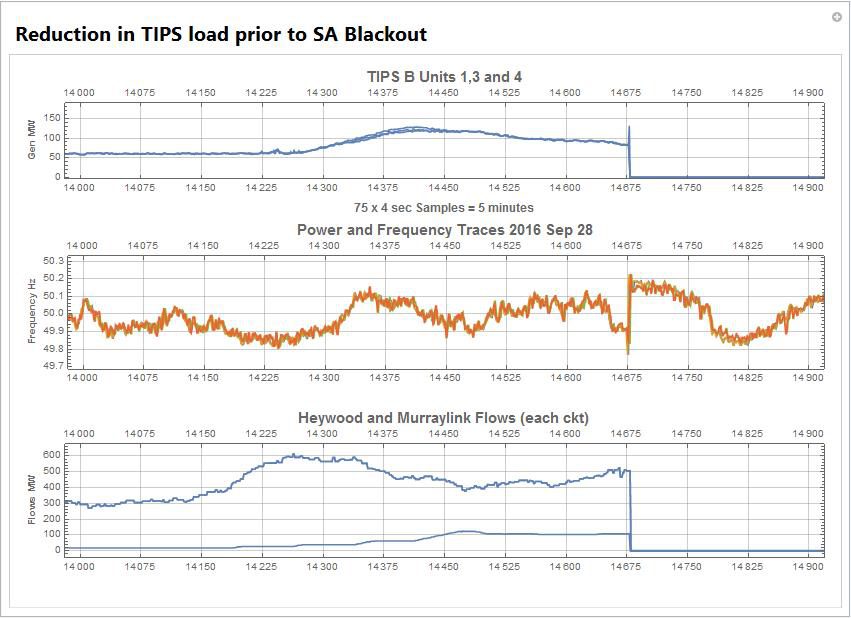Those who cannot learn from history are doomed to repeat it.
It seems this might apply to power systems engineering as well as other walks of life.
It has been over a year since the power system blackout of SA, which was not particularly novel from a technical viewpoint, but the ramifications of which have imposed itself on the body politic of Australia in ever increasing circles like ripples on a pond from a dropped stone – or an impressively sized meteorite.
We have had various reviews and reports into the incident itself, the Finkel review into power system reliability, the establishment of the Energy Security Board (ESB) and a rapid roll out of various National Electricity rule (NER) changes.
In this article, I am going to concentrate on just one aspect of the SA blackout, which is important – I would say critical – for preventing future similar events. That issue is regulation of system frequency and in particular how it relates to controlling power flows across interconnectors between regions.
The graphic above shows that the thermal power station at Torrens Island Power Station (TIPS) was ramping down in load (after initially ramping up) for about 15 minutes prior to the blackout. This (along with the loss of wind farm generation due to system faults) contributed to an increase in flows across the Heywood Interconnector which ultimately tripped due to high power flows.
In hindsight this was exactly the wrong thing to do. However all this power station was doing was following its power dispatch set point so it was not any way at fault.
It’s dispatch set point is set by the market, and there are two ways this can happen, via the price it bids for energy, and via the price it bids for frequency control ancillary services (FCAS).
As it happened on the day in question TIPS elected not to bid for regulation frequency services, and we understand no other generator inside South Australia did either. This means that if the frequency of the system declines (which the graphic shows happened about 2-3 minutes before the event) then corrective action is applied outside of South Australia to raise the system frequency.
We can work out which units were involved in applying the correction by looking at their respective outputs. All of them were outside South Australia. Even Tasmania via Basslink was supporting the mainland system frequency – everywhere except where it was needed which was inside South Australia itself.
So here’s the crux of the issue:
How units are dispatched critically impacts power system security, but currently this is ignored in the design of our regulation FCAS markets. On the day of the SA blackout no units inside SA were participating in the regulation FCAS markets, in fact many units (TIPS in particular) were being dispatched downward by energy market signals.
Accordingly we shouldn’t be too surprised that the Heywood Interconnector had little headroom when the tornados rolled across the state knocking down transmission lines.
The markets had created a situation which made the state’s power system vulnerable to failure.
In discussions with other industry professionals on this subject a few points have been raised which I personally disagree with. I will briefly answer why below:
Raised Point 1- There was no frequency issue before the Heywood interconnector tripped because the system was operating within frequency bounds.
I disagree – in my view the allowable tolerance on system frequency is too wide and should be tightened. If it were, then tie line control could be easily introduced, which would allow better control of interconnector power flows. Having wide frequency ranges also slows down contingency frequency responses of governor control systems and limits the sensitivity that ‘under frequency’ load shedding schemes can be safely set to.
Operating a power system with wide frequency ranges is like driving a car with a loose steering wheel.
Raised point 2 – TIPS power output was not changing prior to the SA blackout.
I take this statement to mean that over a relatively short time frame the output of TIPS was unchanged.
When considering frequency regulation, a longer time frame is more appropriate. As the graphs above clearly show, TIPS was ramping down its power output immediately before the blackout occurred.
It should also be noted that TIPS was not the only generation which was changing over this period, in particular some wind generators were also changing their power outputs but in their case it was in response to system faults, not market directions.
Both of the statements above miss the point. Just because a power system is operating within designated frequency bounds, does not imply those bounds are appropriate. It is a circular argument to say there is no problem because limits are not being exceeded, and because limits are not being exceeded there is no problem.
So how do we avoid similar incidents in the future? I.e. how do we learn from history?
The following would go a long way to improving power system security:
(1) Regulation FCAS should be divided between regions; with regions at the far ends of the network (South Australia and North Queensland) allocated amounts that ensure the power flows on their critical transmission links are adequately controlled.
Currently it is allocated across the mainland purely on bid price. This can lead to situations where some regions have no regulation FCAS enabled.
(2) Tie line control should be introduced at weak points on the system to reduce the risk that interconnector flows reach dangerous levels.
Currently interconnector flows are free to operate at any level subject to defined constraint equations which can rapidly be overtaken by unforeseen events (such as the trip of several transmission lines).
There are many other issues that also need addressing which relate to other aspects of the ancillary services market, but this will take us too far afield from the subject of this article.
Future articles will look at contingency FCAS and the workings of the ancillary services market.
About our Guest Author
|
|
Bruce Miller is an Electrical Engineer from a High Voltage Power systems background. He has experience in design, commissioning and project management and the development of mathematical and software tools.
He currently manages a team of highly skilled engineering and software specialists who carry out planning, technical and commercial studies for clients to assist them in obtaining low cost, clean energy which is safe and reliable. You can find Bruce on LinkedIn here. |




Good analysis.
But what amazes me how quickly good engineering management has been forgotten and replaced by market place substitutes. You write how no one in SA had bid for frequency control. This remark is akin to suggesting that on flight XYZ no one bit to put wings on the plane. These are not market place discussions – these are not things that come from “commercial’ decisions – common sense suggest certain things should happen or be done. If this ludicrous idea of leaving critical decisions to the market place is to continue then there has to be consequences of such omissions – like for example what happened in SA should have costed someone something like $50m. There are minimum technical requirements for reliable and cost effective outcomes. If all of this is handed over to the market place then there has to be the service guarantee with heavy consequences for not meeting objectively stated outcomes. What we have now in Australia is not more than 50% of the processes that are required in a completely commercialized market.
Telling one of my engineering friends that migrated to California 50 years ago about the SA event last year and his first reaction was who will pay the $50m that someone in California would have had if that had happened there.
The main problem Australia faces is the rules of engagement were written buy the guys that hate rules. It is as if we had asked the criminals to write the laws. Of course they would have stopped people going to jail and all the nasty consequences.
Our problems will continue for ever no matter how many inquires or investigations until (1) we stop asking people that have vested interest or
(2) we ask someone without vested interest but who know what they are are doing.
Because up to now all they people that know what they are doing are too close to be impartial and impartial people don’t know what is what having never run anything let alone a grid.
“There are minimum technical requirements for reliable and cost effective outcomes.”
Such as no generator can tender any more electrons than they can reasonably guarantee the supply of 24/7, all year round? Furthermore should every generator also be in a position to contribute to frequency control if and as required? Are some specific types of generators being given a free pass with those basic requirements now and if so why so?
OTOH don’t those 2 requirements really matter for overall grid performance and end consumer satisfaction?
Hi observa, the current FCAS rules allow all generators to get a “free ride” as in they don’t have to contribute to frequency control if they so choose. The market is meant to sort that out by price signals encouraging re-entry. However my observation is that the ancillary services market doesn’t work very well, and in my view it was a flawed idea in the first place. It is like setting up a market to determine which side of the road you should drive on, penalise drivers who drive on the wrong side and reward drivers who drive on the right side. Do this on the basis that the most efficient side will be chosen in all possible circumstances. If we organised our road system like this we would have more efficient transport ? or would we have chaos?
Hi Ken, I agree, good engineering philosophies are being overridden by dogmatic attitudes in many cases. In part that is because the engineering profession is not communicating very well but communication is a two way street and it is also the case that regulators and rule makers etc. are not listening. Maybe a few more failures need to occur for the points to sink in.
Hi Bruce,
There are many lessons to be taken from the story of the railways in Britain between about 1830 and 1870. In many ways what we call “capitalism” was born at that time with people buying shares in railways And then in the latter part of that period what was happening in the US. But the more important lessons come from Britain. It was at that time the ICE, the Institution of Civil Engineers moved to near Parliament because the story of the railways is a story of equal measure of Legislation and private investment. The railways wanted land in a continuous strip that could only be purchased by compulsory acquisition by Legislation and many conditions were placed on the railways in exchange for Parliamentary assistance in getting the land for them. And so capitalism in many ways was not born where there were no rules and money bought everything but in a partnership between government and private investment. And the monopolistic conditions of the grid are very similar to the monopoly of the a railway. Our government be it Labor or Liberal have no idea about how to write appropriate Legislation, so they have turned to people that do know what they are doing but they have serious vested interests and endless conflicts of interest. We Engineers need to get off our bikes and advise the various Ministers. I, acting alone, have done a lot of this in the past few years and in my long life I have never met situations where those I have tried to talk to are not even slightly interested in what I have say
Ken.